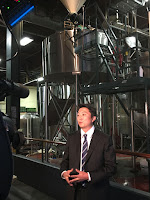WSDA Media Relations Coordinator
 |
| Taylor Shellfish Co. International Sales Manager Tom Bettinger explains the finer points of oyster tasting to WSDA Trade Specialist Elisa Daun and overseas contractor Danny Kim. |
Bettinger was leading a facility tour for a small group of overseas representatives contracted by WSDA to assist Washington agriculture exporters and promote our state's agricultural products in Asia.
Export assistance in key locations
With these contractors on the ground in key trading nations, WSDA's International Marketing Program helps build Washington's international reputation as a reliable source of wide-ranging, high quality agricultural products delivered at the highest safety and handling standards. By promoting this brand identity, the program puts Washington companies in position to export their products efficiently and profitably. And when producers encounter regulatory, logistic, or other exporting issues, the contractors are well positioned to provide assistance.
 |
| WSDA overseas representatives with Director Derek Sandison. From the left: Scott Hitchman, Li Haidong, Sandison, Francis Lee and Danny Kim. |
This year, in addition to their typical jam-packed itinerary, the annual visit was documented by a television crew from Seattle’s Q-13 FOX channel. Reporter Nadia Romero and camera crew interviewed the representatives and several of the producers who attended the seller meetings in Seattle.
Fresh is best
 |
| Hale's Ales Sales Manager Bill Preib talks to Q-13 reporter Nadia Romero about how WSDA consultants helped him evaluate Asia's beer market. |
Back in Shelton, as we walked through the seafood plant with Bettinger, we could almost taste the oysters, clams, mussels and geoducks and the Puget Sound waters from which they were plucked that same morning.
Throughout bustling but immaculate facilities, the sweet, fresh smell of seafood infuses the air like the smell of the ocean on a cool coastal breeze – that must be the nectar.
Crews clad in heavy vinyl rain gear hovered along production lines cleaning, sorting, shucking, and packing the briny harvest. They hosed down the floors, swung forklifts in and around rows of crates and shells, and loaded tractor trailer trucks headed straight for the airport every day to deliver the goods to restaurants in Shanghai, Ho Chi Min City, and Tokyo and Seoul.
Oysters pulled from the water on Monday morning will be served on the half shell half a world away by Wednesday night, Bettinger said.
Representative Francis Lee described what he believes is "the biggest selling point for most seafood in Asia" with a single word: “fresh.” He smiled because he knows his buyers well and he knows he is working with a company that can meet that central demand.
 |
| Bettinger talks freshness with Francis Lee. |
 |
| Q-13 TV interviews Danny Kim. |
In addition to these four overseas contractors, WSDA's International Marketing Program team includes five program staff based throughout the state.
Export expertise for Washington sellers
As liaisons between in-state sellers and overseas buyers, these reps juggle many tasks to assist producers who are interested or engaged in selling their products outside the U.S. They maintain databases of buyers, distributors and importers, keep up on market trends, industry news and regulatory compliance issues, and meet with businesses and government officials.
Bettinger said the reps can really be lifesavers.
"Recently, when we sent a container of cooked oyster meat to Vietnam, there was an issue with the health certificate. It was going to be parked and have to be returned back to the U.S.," he said. "Francis jumped on it and got it cleared up. That is a good example of sending up an SOS and getting rescued."
And even when operations are running smoothly, Bettinger said having reps helps.
"It's a lot easier to be in-country, with the representative there, and talk about an issue or talk about a potential sale than it is to try to do everything by e-mail."
Here are a few links where you can find more information about WSDA’s International Marketing Program, upcoming international marketing events, and the overseas contractors.









